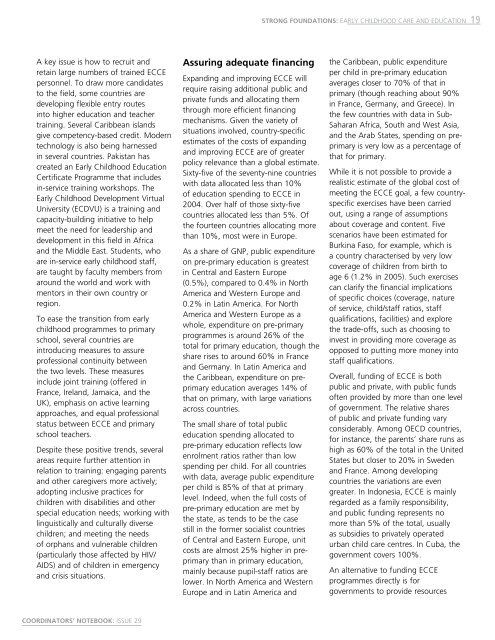A global call to action for early childhood
A global call to action for early childhood
A global call to action for early childhood
You also want an ePaper? Increase the reach of your titles
YUMPU automatically turns print PDFs into web optimized ePapers that Google loves.
Strong foundations: Early <strong>childhood</strong> care and education<br />
19<br />
A key issue is how <strong>to</strong> recruit and<br />
retain large numbers of trained ECCE<br />
personnel. To draw more candidates<br />
<strong>to</strong> the field, some countries are<br />
developing flexible entry routes<br />
in<strong>to</strong> higher education and teacher<br />
training. Several Caribbean islands<br />
give competency-based credit. Modern<br />
technology is also being harnessed<br />
in several countries. Pakistan has<br />
created an Early Childhood Education<br />
Certificate Programme that includes<br />
in-service training workshops. The<br />
Early Childhood Development Virtual<br />
University (ECDVU) is a training and<br />
capacity-building initiative <strong>to</strong> help<br />
meet the need <strong>for</strong> leadership and<br />
development in this field in Africa<br />
and the Middle East. Students, who<br />
are in-service <strong>early</strong> <strong>childhood</strong> staff,<br />
are taught by faculty members from<br />
around the world and work with<br />
men<strong>to</strong>rs in their own country or<br />
region.<br />
To ease the transition from <strong>early</strong><br />
<strong>childhood</strong> programmes <strong>to</strong> primary<br />
school, several countries are<br />
introducing measures <strong>to</strong> assure<br />
professional continuity between<br />
the two levels. These measures<br />
include joint training (offered in<br />
France, Ireland, Jamaica, and the<br />
UK), emphasis on active learning<br />
approaches, and equal professional<br />
status between ECCE and primary<br />
school teachers.<br />
Despite these positive trends, several<br />
areas require further attention in<br />
relation <strong>to</strong> training: engaging parents<br />
and other caregivers more actively;<br />
adopting inclusive practices <strong>for</strong><br />
children with disabilities and other<br />
special education needs; working with<br />
linguisti<strong>call</strong>y and culturally diverse<br />
children; and meeting the needs<br />
of orphans and vulnerable children<br />
(particularly those affected by HIV/<br />
AIDS) and of children in emergency<br />
and crisis situations.<br />
Assuring adequate financing<br />
Expanding and improving ECCE will<br />
require raising additional public and<br />
private funds and allocating them<br />
through more efficient financing<br />
mechanisms. Given the variety of<br />
situations involved, country-specific<br />
estimates of the costs of expanding<br />
and improving ECCE are of greater<br />
policy relevance than a <strong>global</strong> estimate.<br />
Sixty-five of the seventy-nine countries<br />
with data allocated less than 10%<br />
of education spending <strong>to</strong> ECCE in<br />
2004. Over half of those sixty-five<br />
countries allocated less than 5%. Of<br />
the fourteen countries allocating more<br />
than 10%, most were in Europe.<br />
As a share of GNP, public expenditure<br />
on pre-primary education is greatest<br />
in Central and Eastern Europe<br />
(0.5%), compared <strong>to</strong> 0.4% in North<br />
America and Western Europe and<br />
0.2% in Latin America. For North<br />
America and Western Europe as a<br />
whole, expenditure on pre-primary<br />
programmes is around 26% of the<br />
<strong>to</strong>tal <strong>for</strong> primary education, though the<br />
share rises <strong>to</strong> around 60% in France<br />
and Germany. In Latin America and<br />
the Caribbean, expenditure on preprimary<br />
education averages 14% of<br />
that on primary, with large variations<br />
across countries.<br />
The small share of <strong>to</strong>tal public<br />
education spending allocated <strong>to</strong><br />
pre-primary education reflects low<br />
enrolment ratios rather than low<br />
spending per child. For all countries<br />
with data, average public expenditure<br />
per child is 85% of that at primary<br />
level. Indeed, when the full costs of<br />
pre-primary education are met by<br />
the state, as tends <strong>to</strong> be the case<br />
still in the <strong>for</strong>mer socialist countries<br />
of Central and Eastern Europe, unit<br />
costs are almost 25% higher in preprimary<br />
than in primary education,<br />
mainly because pupil-staff ratios are<br />
lower. In North America and Western<br />
Europe and in Latin America and<br />
the Caribbean, public expenditure<br />
per child in pre-primary education<br />
averages closer <strong>to</strong> 70% of that in<br />
primary (though reaching about 90%<br />
in France, Germany, and Greece). In<br />
the few countries with data in Sub-<br />
Saharan Africa, South and West Asia,<br />
and the Arab States, spending on preprimary<br />
is very low as a percentage of<br />
that <strong>for</strong> primary.<br />
While it is not possible <strong>to</strong> provide a<br />
realistic estimate of the <strong>global</strong> cost of<br />
meeting the ECCE goal, a few countryspecific<br />
exercises have been carried<br />
out, using a range of assumptions<br />
about coverage and content. Five<br />
scenarios have been estimated <strong>for</strong><br />
Burkina Faso, <strong>for</strong> example, which is<br />
a country characterised by very low<br />
coverage of children from birth <strong>to</strong><br />
age 6 (1.2% in 2005). Such exercises<br />
can clarify the financial implications<br />
of specific choices (coverage, nature<br />
of service, child/staff ratios, staff<br />
qualifications, facilities) and explore<br />
the trade-offs, such as choosing <strong>to</strong><br />
invest in providing more coverage as<br />
opposed <strong>to</strong> putting more money in<strong>to</strong><br />
staff qualifications.<br />
Overall, funding of ECCE is both<br />
public and private, with public funds<br />
often provided by more than one level<br />
of government. The relative shares<br />
of public and private funding vary<br />
considerably. Among OECD countries,<br />
<strong>for</strong> instance, the parents’ share runs as<br />
high as 60% of the <strong>to</strong>tal in the United<br />
States but closer <strong>to</strong> 20% in Sweden<br />
and France. Among developing<br />
countries the variations are even<br />
greater. In Indonesia, ECCE is mainly<br />
regarded as a family responsibility,<br />
and public funding represents no<br />
more than 5% of the <strong>to</strong>tal, usually<br />
as subsidies <strong>to</strong> privately operated<br />
urban child care centres. In Cuba, the<br />
government covers 100%.<br />
An alternative <strong>to</strong> funding ECCE<br />
programmes directly is <strong>for</strong><br />
governments <strong>to</strong> provide resources<br />
COORDINATORS’ NOTEBOOK: ISSUE 29
















